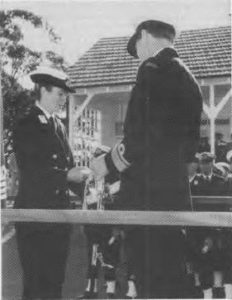- Author
- Barton, J.P., Midshipman, RAN
- Subjects
- History - general
- Tags
-
- RAN Ships
- None noted.
- Publication
- April 1993 edition of the Naval Historical Review (all rights reserved)
INTRODUCTION

1. The designation of “Royal Australian Navy” by King George V on 10th July, 1911 saw the realisation of a plan to form an independent navy controlled by Australians and manned by Australians. From the arrival of the First Fleet, the colony of New South Wales had relied upon the Royal Navy for its naval defence, However, by the mid 1800s the colony became concerned about its defences, seeing the provisions made by the Admiralty as being inadequate. As a consequence of this, Australia wanted to be able to provide its own defences. Here began the battle for that independence.
2. Between the mid 1800s and 1911 there were many factors that led to the formation of the Royal Australian Navy. These factors include events in history, Acts of Parliament and the determination of the characters concerned, culminated in the creation of the Royal Australian Navy.
THE DISCOVERY OF GOLD
3. From the settlement of the colony of New South Wales until the stationing of a man-o-war at Sydney in 1821, Australia was protected by the Royal Navy through the domination it had of every ocean. There had been no need for a substantial naval presence to protect the colony. However, the situation changed in 1851 when gold was discovered in Victoria and New South Wales. This led to an influx of people into the country and the population increased at a rapid rate. By the end of the 1850s the population had trebled. Consequently, those two colonies needed naval protection.
4. In 1853 Lieutenant Governor La Trobe of Victoria discussed with the Secretary of State for the Colonies the lack of Royal Navy protection for the colony and requested that a warship be based there permanently. To serve this role the H.M.S. ELECTRA became a part of the Eastern Imperial Squadron and was to be based in Port Phillip. However, a Select Committee of the Legislative Council found that the ELECTRA was inadequate to protect the coastal shipping and requested a war steamer be sent to replace the ELECTRA.
5. Captain Sir Charles Hotham replaced La Trobe. As an experienced Naval Officer, he deemed that the replacement to ELECTRA would also be inadequate. At this time the Russians were beginning to pose a possible threat to Australia and to counter this threat funds were allocated for the construction of a warship. The London “Times” in an article covering the launch of the ship claimed “…this event marks the formation of a great Navy in the Southern Seas”. The ship was the VICTORIA. The colony of New South Wales also ordered the construction of a ship, the SPITFIRE. The construction of these ships for the colonies showed their desire to provide for their own defence and was a step towards an Australian navy.
RUSSIAN EXPANSIONISM
6. As previously mentioned one of the reasons why the colony feared for their defence was the growing power of the Russians. The Crimean War broke out in 1854 when Britain and France declared war on Russia. At this time there were only six small, inadequately armed RN ships in Australian waters. Even on the completion of the war the British remained suspicious of the Russian’s intentions and therefore Australia was also suspicious. There were concerns that Russia was an empire trying to expand. In 1858 a Royal Commission in New South Wales named Russia as a potential aggressor. By 1859 the Admiralty realised the need to increase the number of RN vessels in Sydney. Therefore on 25th March, 1859 the Australian Squadron of the Royal Navy was created. The vulnerability felt by the Australians at this time highlighted the need for Australia to be able to be involved in its own defence.
COLONIAL NAVAL DEFENCE ACT
7. The first major step towards the creation of the Royal Australian Navy occurred in 1865 with the ratifying of the Colonial Naval Defence Act. The Imperial Government was concerned that ships of the colony would not be recognised by a foreign power when deployed outside colonial waters. In addition, the costs related to the maintenance of naval forces in foreign colonies was a concern to the Imperial Government.




